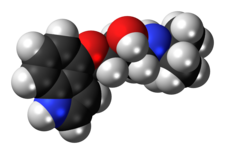Pindolol
 | |
 | |
| Clinical data | |
|---|---|
| Trade names | Visken, others[1] |
| AHFS/Drugs.com | Monograph |
| MedlinePlus | a684032 |
| Pregnancy category |
|
| Routes of administration | By mouth, intravenous |
| ATC code | |
| Legal status | |
| Legal status |
|
| Pharmacokinetic data | |
| Bioavailability | 50% to 95% |
| Metabolism | Hepatic |
| Elimination half-life | 3–4 hours |
| Excretion | Renal |
| Identifiers | |
| |
JSmol) | |
| Chirality | Racemic mixture |
| |
| |
| | |
Pindolol, sold under the brand name Visken among others, is a nonselective
Medical uses
Pindolol is used for
Contraindications
Similar to propranolol with an extra contraindication for hyperthyroidism. In patients with thyrotoxicosis, possible deleterious effects from long-term use of pindolol have not been adequately appraised. Beta-blockade may mask the clinical signs of continuing hyperthyroidism or complications, and give a false impression of improvement. Therefore, abrupt withdrawal of pindolol may be followed by an exacerbation of the symptoms of hyperthyroidism, including thyroid storm.[8]
Pindolol has
Pharmacology
Pharmacodynamics
| Site | Ki (nM) | Species | Ref |
|---|---|---|---|
| 5-HT1A | 15–81 | Human | [10][11][12] |
| 5-HT1B | 4,100 34–151 |
Human Rodent |
[11] [9][13][14] |
| 5-HT1D | 4,900 | Human | [11] |
| 5-HT1E | >10,000 | Human | [15] |
| 5-HT1F | >10,000 | Human | [16] |
| 5-HT2A | 9,333 | Human | [17] |
| 5-HT2B | 2,188 | Human | [17] |
| 5-HT2C | >10,000 | Human | [17] |
| 5-HT3 | ≥6,610 | Multiple | [18][19][20] |
| 5-HT4 | >10,000 ? | Rat | [21] |
| 5-HT5B | >1,000 | Rat | [22] |
| 5-HT6 | >10,000 (–) | Mouse | [23] |
| 5-HT7 | >10,000 | Human | [24][25] |
| α1 | 7,585 | Pigeon | [18] |
| α2 | ND | ND | ND |
| β1 | 0.52–2.6 | Human | [12][26] |
| β2 | 0.40–4.8 | Human | [12][26] |
| β3 | 44 | Human | [26][27] |
| D2-like | >10,000 | Rat | [28] |
| D2 |
>10,000 | Pigeon | [18] |
| D3 |
>10,000 | Pigeon | [18] |
| M1 | ? | ? | |
| Values are Ki (nM), unless otherwise noted. The smaller the value, the more strongly the drug binds to the site. | |||
Pindolol is a first generation,
Pharmacokinetics
Pindolol is rapidly and well absorbed from the GI tract. It undergoes some first-pass-metabolization leading to an oral bioavailability of 50-95%. Patients with uremia may have a reduced bioavailability. Food does not alter the bioavailability, but may increase the resorption. Following an oral single dose of 20 mg peak plasma concentrations are reached within 1–2 hours. The effect of pindolol on pulse rate (lowering) is evident after 3 hours. Despite the rather short halflife of 3–4 hours, hemodynamic effects persist for 24 hours after administration. Plasma halflives are increased to 3–11.5 hours in patients with renal impairment, to 7–15 hours in elderly patients, and from 2.5 to 30 hours in patients with liver cirrhosis. Approximately 2/3 of pindolol is metabolized in the liver giving hydroxylates, which are found in the urine as gluconurides and ethereal sulfates. The remaining 1/3 of pindolol is excreted in urine in unchanged form.
History
Pindolol was patented by Sandoz in 1969 and was launched in the US in 1977.[31] Towards end of February 2020 FDA added this product to their "DRUG SHORTAGE" list stating this is due to "Shortage of an active ingredient" and this is likely to be related to Coronavirus outbreak and related supply chain impacts.
Research
Depression
Pindolol has been investigated as an
Others
- Pindolol is a potent scavenger of nitric oxide. This effect is potentiated by sodium bicarbonate. Inhibition of nitric oxide synthesis has an anxiolytic effect in animals.[35]
- Augmentation therapy of premature ejaculation: According to a recent study, pindolol can be effectively added to a standard anti-premature-ejaculation therapy, which usually consists of daily doses of an SSRI antidepressant such as fluoxetine or paroxetine. Augmentation of pindolol results in substantial increase of ejaculatory latency, even in those who previously did not experience in an improvement with the SSRI monotherapy.[36]
See also
References
- ^ a b Drugs.com International brand names for pindolol Archived 2017-10-01 at the Wayback Machine Page accessed Sept 4, 2015
- ^ PMID 25427719.
- ^ PMID 9635544.
- ^ S2CID 31931009.
- ^ S2CID 205925716.
- ^ Mundo, Emanuela, Emanuela Guglielmo, and Laura Bellodi. "Effect of adjuvant pindolol on the antiobsessional response to fluvoxamine: a double blind, placedo-controlled study." International clinical psychopharmacology 13, no. 5 (1998): 219-224.
- ^ Sassano-Higgins, S.A. and Pato, M.T., 2015. Pindolol augmentation of selective serotonin reuptake inhibitors and clomipramine for the treatment of obsessive-compulsive disorder: A meta-analysis. Journal of Pharmacology and Pharmacotherapeutics, 6(1), pp.36-38.
- ^ a b "RxMed: Pharmaceutical Information - VISKEN". Archived from the original on 2011-09-27. Retrieved 2010-08-15.
- ^ a b Roth BL, Driscol J. "PDSP Ki Database". Psychoactive Drug Screening Program (PDSP). University of North Carolina at Chapel Hill and the United States National Institute of Mental Health. Retrieved 14 August 2017.
- PMID 2078271.
- ^ PMID 1565658.
- ^ PMID 17804228.
- S2CID 35553281.
- PMID 11050366.
- PMID 1513320.
- PMID 8380639.
- ^ S2CID 8938111.
- ^ PMID 9163561.
- S2CID 1594844.
- PMID 3352595.
- PMID 8730742.
- PMID 8224165.
- PMID 8394987.
- PMID 8226867.
- PMID 9298538.
- ^ S2CID 878491.
- PMID 11243572.
- S2CID 9578132.
- PMID 18092107.
- PMID 16475955.
- ISBN 9780941901215 p 185
- ^ Pérez, V., Gilaberte, I., Faries, D., Alvarez, E. and Artigas, F., 1997. Randomised, double-blind, placebo-controlled trial of pindolol in combination with fluoxetine antidepressant treatment. The Lancet, 349(9065), pp.1594-1597.
- ^ S2CID 3740987.
- PMID 11022403.
- PMID 15916777.
- S2CID 9936458.
